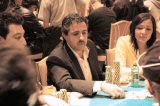SECTION 13 – 14
SECTION 13 – KILL POTS
To kill a pot means to post an overblind that increases the betting limit. A full kill is double the amount of the big blind, and doubles the betting limits. A half kill is one-and-a-half times the big blind, and increases the betting limits by that amount. A kill may be optional in a game, and is often used at lowball when a player wants to be dealt in right away instead of waiting to take the big blind. A kill may be required in a game for any time a specified event takes place. In high-low split games using a required kill, a player who scoops a pot bigger than a set size must kill the next pot. In other games using a required kill, a player who wins two consecutive pots must kill the next pot. In this type of kill game, a marker called a “kill button” indicates which player has won the pot, and the winner keeps this marker until the next hand is completed. If the player who has the kill button wins a second consecutive pot and it qualifies monetarily, that player must kill the next pot.
RULES OF KILL POTS
1. The kill button is neutral (belonging to no player) if:
(a) It is the first hand of a new game.
(b) The winner of the previous pot has quit the game.
(c) The previous pot was split and neither player had the kill button.
2. In a kill pot, the killer acts in proper turn (after the person on the immediate right).
3. There is no pot-size requirement for the first pot or “leg” of a kill. For the second “leg” to qualify for a kill, you must win at least one full bet for whatever limit you are playing, and it cannot be any part of the blind structure.
4. If a player with one “leg up” splits the next pot, that player still has a “leg up” for the next hand. If the player who split the pot was the kill in the previous hand, then that player must also kill the next pot.
5. A person who leaves the table with a “leg up” toward a kill still has a “leg up” upon returning to the game.
6. A player who is required to post a kill must do so that same hand even if wishing to quit or be dealt out. A player who fails to post a required kill blind will not be allowed to participate in any game until the kill money is posted.
7. Kill blinds are considered part of the pot. If a player with a required kill wins again, then that player must kill it again (for the same amount as the previous hand).
8. When a player wins both the high and the low pot (“scoops”) in a split-pot game with a kill provision, the next hand will be killed only if the pot is at least five times the size of the upper limit of the game.
9. If you are unaware that the pot has been killed and put in a lesser amount, if it is a required kill pot with the kill button faceup, you must put in the correct amount. If not, you may withdraw the chips and reconsider your action.
10. In lowball, an optional rule is allowing players to look at their first two cards and then opt whether to kill the pot. The pot may no longer be killed if any player in the game has received a third card. In order to kill the pot voluntarily, you must have at least four times the amount of the kill blind in your stack. For example: If the big blind is two chips, and the kill blind is four chips, the voluntary killer must have at least 16 chips prior to posting the kill. If this rule is used, it is in conjunction with having the killer act last on the first betting round rather than in proper order.
11. Only one kill is allowed per deal.
12. A new player is not entitled to play in a killed pot, but may do so by agreeing to kill the next pot.
13. Broken game status is allowed only for players of the same limit and game type. For this purpose, a game with a required kill is considered a different type of game than an otherwise similar game without a required kill.
<– Previous (Draw High) | Next (Tournaments)
RULES INDEX | Printer Friendly (this section only) –>
[Back to Top]
SECTION 14 – NO LIMIT AND POT-LIMIT
A no-limit or pot-limit betting structure for a game gives it a different character from limit poker, requiring a separate set of rules in many situations. All the rules for limit games apply to no-limit and pot-limit games, except as noted in this section. No-limit means that the amount of a wager is limited only by the table stakes rule, so any part or all of a player’s chips may be wagered. The rules of no-limit play also apply to pot-limit play, except that a bet may not exceed the pot size. The player is responsible for determining the pot size at no-limit, not the dealer. The dealer is responsible for determining the pot size at pot-limit, and should enforce the pot-size cap on wagers without waiting to be asked to do so by a player. For those rules that apply only to no-limit and pot-limit lowball, see the sub-section at the end of “Section 11 – Lowball.”
NO-LIMIT RULES
1. The number of raises in any betting round is unlimited.
2. The minimum bet size is the amount of the minimum bring-in, unless the player is going all-in. The minimum bring-in is the size of the big blind unless the structure of the game is preset by the house to some other amount (such as double the big blind). The minimum bet remains the same amount on all betting rounds. If the big blind does not have sufficient chips to post the required amount, a player who enters the pot on the initial betting round is still required to enter for at least the minimum bet (unless going all-in for a lesser sum) and a preflop raiser must at least double the size of the big blind. At all other times, when someone goes all-in for less than the minimum bet, a player has the option of just calling the all-in amount. If a player goes all-in for an amount that is less than the minimum bet, a player who wishes to raise must raise at least the amount of the minimum bet. For example, if the minimum bet is $100, and a player goes all-in on the flop for $20, a player may fold, call $20, or raise to at least a total of $120
3. All raises must be equal to or greater than the size of the previous bet or raise on that betting round, except for an all-in wager. Example: Player A bets 100 and player B raises to 200. Player C wishing to raise must raise at least 100 more, making the total bet at least 3. A player who has already checked or called may not subsequently raise an all-in bet that is less than the full size of the last bet or raise. (The half-the-size rule for reopening the betting is for limit poker only.)
4. Multiple all-in wagers, each of an amount too small to qualify as a raise, still act as a raise and reopen the betting if the resulting wager size to a player qualifies as a raise.Example: Player A bets $100 and Player B raises $100 more, making the total bet $200. If Player C goes all in for less than $300 total (not a full $100 raise), and Player A calls, then Player B has no option to raise again, because he wasn’t fully raised. (Player A could have raised, because Player B raised.)
5. “Completing the bet” is a limit poker wager type only, not allowed at big-bet poker.
6. At non-tournament play, a player who says “raise” is allowed to continue putting chips into the pot with more than one move; the wager is assumed complete when the player’s hands come to rest outside the pot area. (This rule is used because no-limit play may require a large number of chips be put into the pot.) In tournament play, the TDA rules require that the player either use a verbal statement giving the amount of the raise or put the chips into the pot in a single motion, to avoid making a string-bet.
7. A wager is not binding until the chips are actually released into the pot, unless the player has made a verbal statement of action.
8. If there is a discrepancy between a player’s verbal statement and the amount put into the pot, the bet will be corrected to the verbal statement.
9. If a call is short due to a counting error, the amount must be corrected, even if the bettor has shown down a superior hand.
10. A bet of a single chip or bill without comment is considered to be the full amount of the chip or bill allowed. However, a player acting on a previous bet with a larger denomination chip or bill is calling the previous bet unless this player makes a verbal declaration to raise the pot. (This includes acting on the forced bet of the big blind .)
11. If a player tries to bet or raise less than the legal minimum and has more chips, the wager must be increased to the proper size. (This does not apply to a player who has unintentionally put too much in to call.) The wager is brought up to the sufficient amount only, no greater size.
12. Because the amount of a wager at big-bet poker has such a wide range, a player who has taken action based on a gross misunderstanding of the amount wagered may receive some protection by the decision-maker. A “call” or “raise” may be ruled not binding if it is obvious that the player grossly misunderstood the amount wagered, provided no damage has been caused by that action. Example: Player A bets $300, player B reraises to $1200, and Player C puts $300 into the pot and says, “call.” It is obvious that player C believes the bet to be only $300 and he should be allowed to withdraw his $300 and reconsider his wager. A bettor should not show down a hand until the amount put into the pot for a call seems reasonably correct, or it is obvious that the caller understands the amount wagered. The decision-maker is allowed considerable discretion in ruling on this type of situation. A possible rule-of-thumb is to disallow any claim of not understanding the amount wagered if the caller has put eighty percent or more of that amount into the pot.
Example: On the end, a player puts a $500 chip into the pot and says softly, “Four hundred.” The opponent puts a $100 chip into the pot and says, “Call.” The bettor immediately shows the hand. The dealer says, “He bet four hundred.” The caller says, “Oh, I thought he bet a hundred.” In this case, the recommended ruling normally is that the bettor had an obligation to not show the hand when the amount put into the pot was obviously short, and the “call” can be retracted. Note that the character of each player can be a factor. (Unfortunately, situations can arise at big-bet poker that are not so clear-cut as this.)
13. All wagers may be required to be in the same denomination of chip (or larger) used for the minimum bring-in, even if smaller chips are used in the blind structure. If this is done, the smaller chips do not play except in quantity, even when going all-in.
14. Since all a player’s chips may be put at risk on a hand, the house has the right to set a maximum amount for the buy-in to help control the effective size of a game.
15. In non-tournament games, one optional live straddle is allowed. The player who posts the straddle has last action for the first round of betting and is allowed to raise. To straddle, a player must be on the immediate left of the big blind , and must post an amount twice the size of the big blind. A straddle bet sets a new minimum bring-in; it is not treated as a raise.
16. In all no-limit and pot-limit games, the house has the right to place a maximum time limit for taking action on your hand. The clock may be put on someone by the dealer as directed by a floorperson, if a player requests it. If the clock is put on you when you are facing a bet , you will have one additional minute to act on your hand. You will have a ten-second warning, after which your hand is dead if you have not acted.
17. The cardroom does not condone “insurance” or any other “proposition” wagers. The management will decline to make decisions in such matters, and the pot will be awarded to the best hand. Players are asked to refrain from instigating proposition wagers in any form. The players are allowed to agree to deal twice (or three times) when someone is all-in. “Dealing twice” means the pot is divided in two, with each portion being dealt for separately.
POT-LIMIT RULES
A bet may not exceed the pot size. The maximum amount a player can raise is the amount in the pot after the call is made. Therefore, if a pot is $100, and someone makes a $50 bet, the next player can call $50 and raise the pot $200, for a total wager of $250.
1. If a wager is made that exceeds the pot size, the surplus will be given back to the bettor as soon as possible, and the amount will be reduced to the maximum allowable.
2. The dealer or any player in the game can and should call attention to a wager that appears to exceed the pot size (this also applies to heads-up pots). The oversize wager may be corrected at any point until all players have acted on it.
3. If an oversize wager has stood for a length of time with someone considering what action to take, that person has had to act on a wager that was thought to be a certain size. If the player then decides to call or raise, and attention is called at this late point to whether this is an allowable amount, the floorperson may rule that the oversize amount must stand (especially if the person now trying to reduce the amount is the person that made the wager).
4. In pot-limit play, it is advisable in many structures to round off the pot size upward to produce a faster pace of play. This is done by treating any odd amount as the next larger size. For example, if the pot size was being kept track of with $25 units, then a pot size of $80 would be treated as a pot size of $100.
5. In pot-limit hold’em and pot-limit Omaha money games, many structures treat the little blind as if it were the same size of the big blind in computing pot size. In such a structure, a player can open for a maximum of four times the size of the big blind. For example, if the blinds are $5 and $10, a player may open with a raise to $40. (The range of options is to either open with a call of $10, or raise in increments of five dollars to any amount from $20 to $40.) Subsequent players also treat the $5 as if it were $10 in computing the pot size, until the big blind is through acting on the first betting round. This rule of treating the little blind as if it were the size of the big blind is especially desirable in a structure where the little blind uses a lower-denomination chip than the big blind, as in using blinds of $10 and $25 (two $5 chips and a $25 chip). At tournament play, strict pot-limit rules are normally used, so there the maximum opening wager is 3.5 times the size of the big blind.
6. In pot-limit, if a chip or a bill larger than the pot size is put into the pot without comment, it is considered to be a bet of the pot size.
<– Previous (Draw High) | Next (Tournaments)
RULES INDEX | Printer Friendly (this section only) –>
[Back to Top]









 Beranda
Beranda
 Whatsapp
Whatsapp
 Daftar
Daftar
 Promosi
Promosi
 Telegram
Telegram